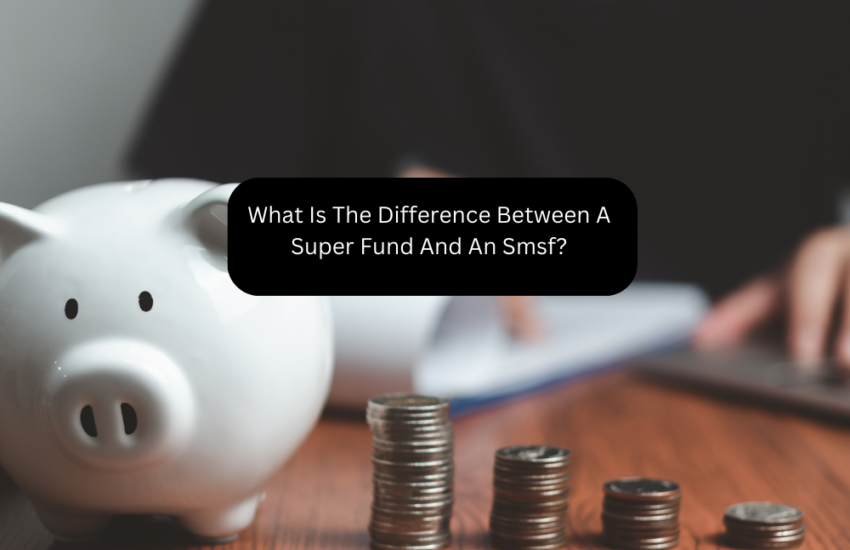Superannuation funds, or super funds as they are more commonly known, play a crucial role in securing financial stability for Australians during retirement. These funds help individuals save and invest money throughout their working years to live comfortably after retirement. However, different types of super funds are available in Australia, with Self-Managed Super Funds (SMSFs) being a popular option among many individuals. While super funds and SMSFs have the same goal of providing financial security, there are significant differences between the two that people should be aware of before choosing one. This article will discuss key differences between super funds and SMSFs in Australia.
Control and flexibility
One of the main differences between super funds and SMSFs lies in individuals’ level of control and flexibility over their investments. Super funds are managed by professional fund managers, who make investment decisions for all fund members. Therefore, individuals do not have direct control over where their money is invested. On the other hand, with an SMSF, the members act as trustees and have complete control over where their funds are invested. It gives individuals more flexibility in choosing investment options that align with their personal preferences and risk appetite.
SMSFs allow for a broader range of investment options than traditional super funds. While super funds typically invest in assets such as stocks, bonds, and cash, SMSFs can also invest in direct property, art, and collectables. It allows SMSF members to diversify their investments and achieve higher returns.
Compliance and regulations
Super funds are regulated by the Australian Prudential Regulation Authority (APRA), which sets strict guidelines for fund management, reporting, and compliance. Therefore, super funds must follow specific rules and regulations to ensure the safety of members’ investments. On the other hand, SMSFs are regulated by the Australian Taxation Office (ATO), which has a more hands-on approach to compliance. Therefore, SMSF trustees have more responsibilities and must adhere to strict reporting requirements.
SMSFs must also comply with complex tax laws, which can be challenging for individuals without financial expertise. Trustees must stay up-to-date with changes in tax laws and ensure that their funds remain compliant to avoid penalties.
Cost
Another significant difference between super funds and SMSFs is the cost involved. Super funds typically charge an annual management fee ranging from 0.5% to 2% of the total investment amount. This fee covers fund management, administration, and other associated costs.
In contrast, SMSFs have more significant upfront costs, such as establishing a trust structure and setting up a bank account for the fund. There are ongoing fees for financial and tax advice and annual audits. These costs can vary depending on the fund size and the investments’ complexity. Therefore, SMSFs may be more cost-effective for individuals with more significant super balances, as the annual fees are fixed regardless of the investment amount.
One way to potentially reduce costs for SMSF members is through a partnership with a trading platform like Saxo Markets. SMSF trustees can access various investment products and tools at competitive prices. This partnership allows for efficient management of investments, reducing the need to hire multiple professionals and incur high fees.
Investment strategy
As mentioned earlier, super funds invest members’ money based on decisions made by professional fund managers. These decisions are guided by the fund’s investment strategy, which outlines how the money will be invested to achieve long-term returns. This strategy is usually conservative and focuses on diversification to reduce risk.
SMSFs, on the other hand, have more flexibility in creating their investment strategy. Trustees can tailor their investments based on their risk appetite, time horizon, and financial goals. However, it is essential to note that SMSFs must have an investment strategy and regularly review and update it as needed.
It is also worth mentioning that SMSF trustees must have sound knowledge and understanding of investing to create a viable investment strategy. Otherwise, they may risk making poor investment decisions that could negatively impact their retirement savings.
Read: OnCredit Loans: Your Path to Financial Empowerment
Insurance
Superfunds typically offer members insurance coverage through group life insurance policies. Therefore, members are covered under a single policy with predetermined benefits. In contrast, SMSF members must set up insurance policies and pay premiums. It can be a disadvantage for SMSFs as they may have different bargaining power than super funds, resulting in higher premiums.
However, SMSF members have more control over their insurance policies and can tailor them to suit their needs. They also have the option to transfer existing policies into their SMSF. Reviewing and updating insurance policies regularly to ensure adequate coverage is essential.
Investors should also be aware that insurance is a crucial aspect of retirement planning, and not having adequate coverage could have severe consequences.
Investment knowledge and management
Managing an SMSF requires significant time, effort, and financial expertise. Trustees must have a good understanding of investment markets and be able to make informed decisions about their investments. They are also responsible for keeping accurate records and ensuring compliance with regulations.
In contrast, super funds are managed by professionals with extensive investment knowledge and experience. It allows members to focus on other aspects of their lives without worrying about managing their super.

